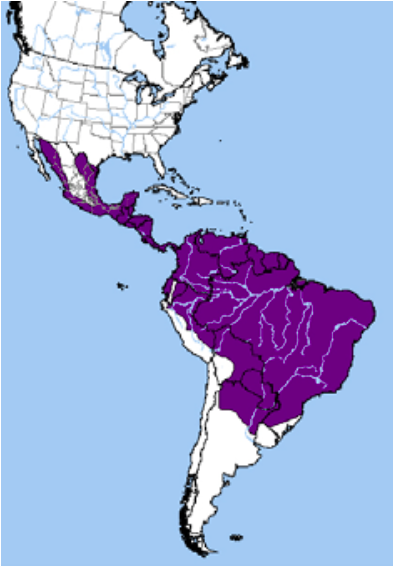The Ocelot, Leopardus pardalis
 |
Figure 1. The Ocelot at Woodland Park Zoo in Seattle, Washington. Photo by Danleo. Published on en.wikipedia.org.
____________________________________________________________________________________________________
What is an Ocelot?
Weighing between 15 and 35 pounds, the ocelot is not your average domestic mouser. This medium-sized cat has a body structure similar to that of a cheetah; a thin, graceful frame that allows for speed and agility while climbing and hunting. The ocelot's coat features beautiful brown spots bordered in black, forming a unique chain link pattern that sweeps across the body. Solid black stripes start on the face and run down the neck and chest area. Ocelots can sport a range of coat colors, from pale to tawny; however, the underside of the cat is usually much lighter than the back.
Figure 2. Wild Ocelot in the Forest. Photo by Frans Lanting. Courtesy of Getty Images.
_______________________________________________________________________________________________________ Ocelots are a mobile and non habitat-specific species, meaning that they do not require a designation of critical habitat for conservation. Ocelots can thrive in many types of habitat, including tropical rainforest, savanna, scrublands, and marshlands. However, they tend to prefer dense areas of habitat in which to hunt. Ocelots are primarily nocturnal, sleeping during the day and hunting for prey such as birds, fish, reptiles, amphibians, and small mammals under the cover of night. Click the link below to watch a video of an adult ocelot teaching its kitten to fish. The video also highlights how skilled ocelots are at climbing: https://www.youtube.com/watch?v=PS4fRKFYDsg&spfreload=10
Fun Fact: The ocelot was once highly valued in the international pet trade; the Spanish surrealist painter Salvador Dali used to travel frequently with his pet ocelot Babou.
Figure 3. (Right) Dali with Bride & Ocelot. Photo by Edward Pfizenmaier. 1964. Where is the Ocelot found?
Would you be surprised to know that this majestic feline resides in our own backyard? The majority of the ocelot's geographic range spans Central and South America; excluding Chile, the ocelot can be found in every mainland country south of the U.S. However, a few subspecies inhabit the extreme southern regions of both Texas and Arizona.
Figure 4. Map of Ocelot Ranges in North and Central America. Graphic by Ashley Slaney. Published on cronkitenewsonline.com. Source: USFWS
The subspecies most prevalent in southern Texas is the Tamaulipas ocelot (leopardus pardalis albescens), while the Sonora ocelot (leopardus pardalis sonoriensis) can be found in southern Arizona. However, sitings in Arizona are extremely rare; a single ocelot was documented in Arizona in 2009 via camera traps. Tamaulipas ocelots aren't faring much better in the U.S.; only two known populations inhabited southern Texas as of 2010, compromised of fewer than fifty individuals in total.
The ocelot is the largest and oldest species in North America from the genus Leopardus. Prehistoric carvings and fossil findings have led to the belief that ocelots might have "ranged over much of the southern U.S.," perhaps even predating the arrival of the Spaniards in the sixteenth century. The near total displacement of ocelots from North America illustrates a drastic change in population patterns and geographic distribution. (USFWS, 2010)
Figure 5. (Left) Ocelot Range Map. Courtesy of Nature Serve. 2007. Why is the ocelot endangered?
The ocelot was listed as Endangered throughout its entire range in the western hemisphere under the Endangered Species Act (ESA) in 1972; the southwestern U.S. populations in particular were listed in 1982. It was labeled a species of "Least Concern" by the International Union for Conservation of Nature (IUCN) in 2008. The ocelot is listed as Endangered in the state of Texas and as a species of "Special Concern" in Arizona, where it is protected from hunting and collection.
Species endangerment for the ocelot has been attributed primarily to habitat conversion, fragmentation, and loss. Especially in the southwestern U.S., human land development and population growth are consistent factors contributing to the decrease of suitable ocelot habitat; collisions with vehicles has been a significant and recent threat to ocelots. The isolation of the Arizona Sonora ocelots from the Texas Tamaulipas ocelots, along with increasingly smaller populations in both regions has led to inbreeding and a lack of genetic diversity within populations. Without significant genetic diversity, a single disease could potentially and completely eradicate ocelot populations in the U.S. How are we going to save the Ocelot? The recovery plan proposed by the U.S. Fish and Wildlife Services under the ESA focuses on providing a migratory corridor for ocelots in the southwest U.S., with the ultimate goal of connecting populations in Texas and Arizona. This commingling of subspecies would serve to increase overall population size and diversify gene pools, thus decreasing inbreeding and the susceptibility for disease and genetic mutation.
Figure 6. (Right) Ocelot. Photo by Jamie Veronica. Courtesy of Big Cat Rescue.
These goals will be deemed partially successful when U.S. ocelot populations consistently achieve a determination of "Least Concern" by the IUCN Red List of Threatened Species for five consecutive years. The plan also requires that the Texas/Tamaulipas populations consistently remain above 200 and 1,000 individuals respectively and the Arizona Sonora population maintains 1,000 individuals for at least five years. The ocelot will only be fully delisted, as neither threatened nor endangered, once these populations have maintained said numbers for at least ten consecutive years.If you enjoyed learning about ocelots, follow the link below for a fun and interactive game offered by the Dallas Zoo Conservation Education Program. It shows how ocelots are studied in the wild by real biologists, and even lets you get in on the action too! Ocelot Experience Game: http://www.dallaszooed.com/games.html |





No comments:
Post a Comment